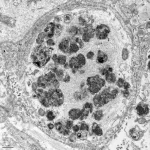(Press-News.org) HERSHEY, Pa. — Rates of babesiosis, a tick-borne parasitic disease, increased an average of 9% per year in the United States between 2015 and 2022 and four in 10 patients were found to be co-infected with another tick-borne illness such as Lyme disease, according to a new study led by researchers at Penn State Health Milton S. Hershey Medical Center and Penn State College of Medicine.
“These findings suggest that clinicians should have a heightened vigilance of co-infection of other tick-borne illness among patients admitted with babesiosis,” said Paddy Ssentongo, infectious disease fellow, Penn State Health Milton S. Hershey Medical Center and lead author of the study. “Ticks can carry other bacteria that cause Lyme disease and other tick-borne diseases like anaplasmosis and ehrlichiosis.”
They published their findings today (Oct 8) in the journal Open Forum Infectious Diseases.
Babesiosis, sometimes referred to as “American malaria,” is caused by the Babesia parasite and is transmitted from bites of black-legged ticks. It’s found primarily in Northeastern and Midwestern states. Like malaria, the parasite infects red blood cells, and the condition shares many similar clinical symptoms. According to the U.S. Centers for Disease Control and Prevention (CDC), although some people do not develop symptoms, others experience flu-like symptoms. The disease can be deadly for older adults and those with certain health conditions, such as a weakened immune system or lack of spleen.
“Understanding the drivers, dynamics and control of endemic and emerging vector-borne diseases is critical for global health interventions,” Ssentongo said.
The prevalence of babesiosis has been rising, according to the CDC. Ssentongo explained that climate change may play a role. Changing factors like temperature, humidity, rainfall and length of season have influenced the population and distribution of vectors like ticks as well as the population of animals that serve as reservoir hosts, like deer. As a result, ticks may be present in a wider geographical area.
The team set out to assess the current prevalence of babesiosis and Babesia co-infections as well as the effect of Babesia co-infection on mortality risk. Using the TriNetX, a large, national database of clinical patient data from over 250 million individuals, they identified 3,521 individuals who were infected with babesiosis between October 2015 and December 2022.
The researchers found that the incidence of babesiosis increased an average of 9% per year. The majority of cases peaked during the summer months and were reported in Northeastern states. Of those diagnosed with babesiosis, 42% were infected with one or more additional tick-borne disease, which is a higher rate than what’s been found in previous studies. The greatest percentage of those patients, 41%, were co-infected with the bacterium responsible for Lyme disease while a smaller portion of patients were co-infected with bacteria that cause ehrlichiosis and anaplasmosis, 3.7% and 0.3%, respectively.
When the team examined if co-infection amplified the risk of complications or led to worse outcomes, they found that there were no significant differences between the babesiosis-only group and the co-infection group. However, when they looked at mortality risk, they found that the risk of death was higher among the babesiosis-only group.
“Having both babesiosis and Lyme disease seemed not to be associated with worse mortality,” Ssentongo said, noting the finding was surprising. “It’s speculated that the concurrent presence of other tick-borne infections in the blood could alter the immune response by possibly ‘boosting’ it to effectively fight infections.”
The difference in outcomes may also have to do with how other tick-borne illnesses are treated, Ssentongo said. In their study, the team found that the co-infection group was more likely to be prescribed doxycycline, the first line antibiotic treatment for Lyme disease, anaplasmosis and ehrlichiosis, compared to the babesiosis-only group. Ssentongo said that it raises a compelling question: Is doxycycline also effective in treating the babesia parasite?
Currently, the treatment of babesiosis depends on disease severity. Treatment typically includes a combination of the antibiotics azithromycin and atovaquone. Red blood cell exchange, where abnormal red blood cells are removed and replaced by healthy ones, can also be considered for severely ill patients such as those with serious organ dysfunction. However, the survival benefit of red blood cell exchange hasn’t been studied extensively.
“For patients with babesiosis, we add on doxycycline as we’re investigating whether or not the patient has Lyme disease or other tick-borne diseases, and we’ve seen better outcomes at our medical center with this approach,” Ssentongo said. He said that there are other case reports where babesiosis has been successfully treated with doxycycline. However, more research is needed to understand the physiological pathways that underlie co-infection and how that might influence treatment protocols.
The most effective treatment approach is preventing tickborne-diseases in the first place, according to Ssentongo.
“If you live in areas where babesiosis is endemic, mostly states in the Northeast and the Midwest, take precautions, especially during the summer months,” Ssentongo said. “Practice tick-bite prevention practices. Wear long-sleeved shirts and pants and light-colored clothes. Use tick repellant and check for ticks after spending time outdoors.”
The study will be presented at IDWeek, the Infectious Disease Society of American annual conference taking place in Los Angeles, California, Oct. 16-19.
Other Penn State authors include Vernon Chinchilli, distinguished professor of public health sciences; Djibril Ba, assistant professor of public health sciences; Natasha Venugopal, internal medicine resident at Penn State Health Milton S. Hershey Medical Center; and Yue Zhang, epidemiology doctoral student.
END
Rates of a tick-borne parasitic disease are on the rise
Cases of babesiosis increased 9% per year, on average, between 2015 and 2022 and nearly half were co-infected with another tick-borne illness such as Lyme disease, according to a new study
2024-10-08
ELSE PRESS RELEASES FROM THIS DATE:
Crohn's & Colitis Foundation survey reveals more than 40% of IBD patients made significant financial sacrifices to pay for their healthcare
2024-10-08
NEW YORK, NY – October 8, 2024 - The Crohn's & Colitis Foundation released findings from its latest healthcare access survey, revealing that more than 40% of inflammatory bowel disease (IBD) patients have made significant financial trade-offs to afford their healthcare. The survey highlighted that among all respondents, 30% reported giving up vacations or major household purchases, 22% increased their credit card debt, and 21% cut back on essential items such as food, clothing, or basic household items.
The survey, published today in Inflammatory Bowel Diseases, included responses ...
Sperm whale departure linked to decline in jumbo squid population in Gulf of California: new study unveils long-term impact on ecosystem health
2024-10-08
A PeerJ Life and Environment study has revealed a significant departure of sperm whales (Physeter macrocephalus) from the central portion of the Gulf of California, linked to the collapse of the jumbo squid (Dosidicus gigas) population, their primary prey. The study, led by researchers Msc. Héctor Pérez-Puig and Dr. Alejandro Arias Del Razo, offers insight into the relationship between apex marine predators and their environment, highlighting sperm whales as key indicators of oceanic health.
The research, conducted over a 9-year period in the eastern Midriff Islands Region of the Gulf of California, utilized extensive survey ...
New apps will enable safer indoor navigation for blind people
2024-10-08
Two new apps will enable blind people to navigate indoor buildings with spoken directions from a smartphone app, providing a safe method of wayfinding where GPS doesn’t work.
UC Santa Cruz professor of Computer Science and Engineering Roberto Manduchi has devoted much of his research career to creating accessible technology for the blind and visually impaired. Throughout years of working with these communities, he has learned that there is a particular need for tools to help with indoor navigation of new spaces.
“Moving about independently in a place that you don't know is particularly ...
Scientists from IOCB Prague help to improve medical drugs
2024-10-08
Researchers from IOCB Prague are furthering the understanding of how medicines work and what it takes to develop their most effective variants. In one current study, they have focused on the disease caused by the protozoan parasite Trichomonas vaginalis, especially because of the recent appearance of strains that are resistant to conventional treatment. In an effort to find a new weak spot of this parasite, the research group led by Dr. Evžen Bouřa has succeeded in preparing a key enzyme complex – the proteasome. This has made it possible to gain knowledge that is indispensable for the development of new effective ...
Recreating a hallmark of Parkinson's disease in human neurons
2024-10-08
Lewy bodies are a hallmark of Parkinson's disease (PD) and other related neurological conditions. Understanding why and how they develop is critical to developing better treatments. A study from The Neuro (Montreal Neurological Institute-Hospital) of McGill University, in collaboration with its Early Drug Discovery Unit, has recreated the growth of Lewy bodies in human neurons and followed their formation to gain important insight into why and how they form. Critically, they find that immune challenge is important for this process, identifying a previously unknown link between the immune system and neurological disease.
Lewy ...
Solar-powered desalination system requires no extra batteries
2024-10-08
MIT engineers have built a new desalination system that runs with the rhythms of the sun.
The solar-powered system removes salt from water at a pace that closely follows changes in solar energy. As sunlight increases through the day, the system ramps up its desalting process and automatically adjusts to any sudden variation in sunlight, for example by dialing down in response to a passing cloud or revving up as the skies clear.
Because the system can quickly react to subtle changes in sunlight, it maximizes the utility of solar energy, producing large quantities of clean water despite ...
When it comes to emergency care, ChatGPT overprescribes
2024-10-08
Generative AI still needs to find the right balance between too little and too much care before it can help doctors make decisions in the Emergency Department.
If ChatGPT were cut loose in the Emergency Department, it might suggest unneeded x-rays and antibiotics for some patients and admit others who didn’t require hospital treatment, a new study from UC San Francisco has found.
The researchers said that, while the model could be prompted in ways that make its responses more accurate, it’s still no match for the clinical judgment of a human doctor.
“This ...
Speakers to tackle global health challenges at WISH 2024
2024-10-08
7 October 2024. Doha, Qatar – The World Innovation Summit for Health (WISH) has today released the first details of speakers confirmed for its upcoming global conference, to be held on 13 and 14 November 2024.
Among those featured at the summit will be WISH executive chair Lord Ara Darzi of Denham and Médecins Sans Frontières’ international president Christos Christou.
Lord Darzi, who recently led an independent investigation on the state of the National Health Service in England, will ...
Mental health app could help prevent depression in young people at high risk
2024-10-08
A cognitive behavioural therapy (CBT) app has been found to significantly prevent increases in depression in young people who are at high risk - and could be implemented as a cost effective public mental health measure.
Globally, concern is growing about the high and steadily increasing rates of anxiety and depression in young people. Effective and scalable ways of preventing poor mental health in this group are needed, and digital tools such as mobile apps have been proposed as part of the solution.
Whilst there is emerging evidence ...
Dogs contaminate London ponds with parasite medications
2024-10-08
Most dog owners didn’t know that flea and tick treatments are dangerous to aquatic life, suggesting more awareness could ease the problem.
A study on Hampstead Heath shows that ponds where dogs are allowed to swim contain levels of two pesticides harmful to invertebrate life.
These pesticides, imidacloprid and fipronil, are used as parasite treatments for flea and tick infestations in cats and dogs, using ‘spot-on’ formulas and flea collars. This is despite these chemicals being banned for agricultural use in 2018 due to their toxicity to bees and other ...
LAST 30 PRESS RELEASES:
Why nail-biting, procrastination and other self-sabotaging behaviors are rooted in survival instincts
Regional variations in mechanical properties of porcine leptomeninges
Artificial empathy in therapy and healthcare: advancements in interpersonal interaction technologies
Why some brains switch gears more efficiently than others
UVA’s Jundong Li wins ICDM’S 2025 Tao Li Award for data mining, machine learning
UVA’s low-power, high-performance computer power player Mircea Stan earns National Academy of Inventors fellowship
Not playing by the rules: USU researcher explores filamentous algae dynamics in rivers
Do our body clocks influence our risk of dementia?
Anthropologists offer new evidence of bipedalism in long-debated fossil discovery
Safer receipt paper from wood
Dosage-sensitive genes suggest no whole-genome duplications in ancestral angiosperm
First ancient human herpesvirus genomes document their deep history with humans
Why Some Bacteria Survive Antibiotics and How to Stop Them - New study reveals that bacteria can survive antibiotic treatment through two fundamentally different “shutdown modes”
UCLA study links scar healing to dangerous placenta condition
CHANGE-seq-BE finds off-target changes in the genome from base editors
The Journal of Nuclear Medicine Ahead-of-Print Tip Sheet: January 2, 2026
Delayed or absent first dose of measles, mumps, and rubella vaccination
Trends in US preterm birth rates by household income and race and ethnicity
Study identifies potential biomarker linked to progression and brain inflammation in multiple sclerosis
Many mothers in Norway do not show up for postnatal check-ups
Researchers want to find out why quick clay is so unstable
Superradiant spins show teamwork at the quantum scale
Cleveland Clinic Research links tumor bacteria to immunotherapy resistance in head and neck cancer
First Editorial of 2026: Resisting AI slop
Joint ground- and space-based observations reveal Saturn-mass rogue planet
Inheritable genetic variant offers protection against blood cancer risk and progression
Pigs settled Pacific islands alongside early human voyagers
A Coral reef’s daily pulse reshapes microbes in surrounding waters
EAST Tokamak experiments exceed plasma density limit, offering new approach to fusion ignition
Groundbreaking discovery reveals Africa’s oldest cremation pyre and complex ritual practices
[Press-News.org] Rates of a tick-borne parasitic disease are on the riseCases of babesiosis increased 9% per year, on average, between 2015 and 2022 and nearly half were co-infected with another tick-borne illness such as Lyme disease, according to a new study






